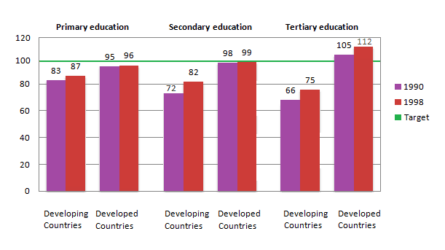-
IELTS Academic Writing Task 1/ Graph Writing – Bar/Column Graph:
IELTS Academic Writing Task 1/ Graph Writing – Bar/Column Graph:
» You should spend about 20 minutes on this task.
The chart below shows the number of girls per 100 boys enrolled in different levels of school education.
Summarise the information by selecting and reporting the main features and make comparisons where relevant.
» Write at least 150 words.
Student Example: 2.5 Bands IELTS
The charts compare the number of female students in comparison with their male peers in all three levels of education between developing and developed nations in two years 1990 and 2000.
It is clear that the biggest difference between two types of countries can be seen in tertiary sector. Moreover, developed countries’ figures were closer to the 2005 targets than developing nations’.
In 1990, there were 83 girls in developing countries attended primary, while the number for developed countries was 93 students. As regard to secondary sector, while the figure for developing countries was 72 girl students, 98 female students in developed countries enrolled in secondary school. The developed countries’ highschool figure were stood at 105 students, while only 66 of their peers in developing countries went to school.
In 2000, both figures in elementary sector witnessed rises, with 4 students in developing nations and 3 girls in developed nations. However, developing countries’ secondary education had the most dramatic change, to 82 students in 2000, compared to a 7 students increase in the developed countries’ tertiary education.
Log in to reply.



